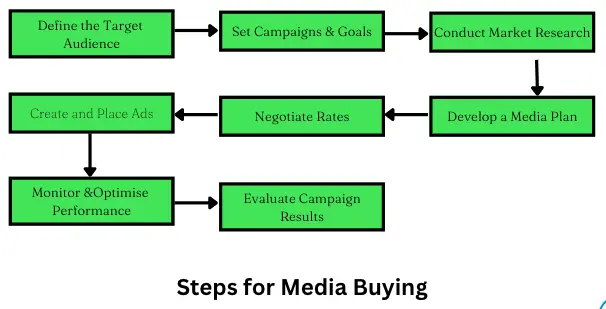Media Buying
Definition
Media buying is purchasing the advertising space or time on various media platforms to reach a target audience.
Description
Media buying is identifying, negotiating, and purchasing advertising space or time on various media platforms such as television, radio, print, outdoor, and digital channels. Media buying aims to reach the target audience in the most cost-effective and efficient manner possible while maximising the return on investment (ROI) for the advertiser.

Source: www.google.com
Media buying involves extensive research, planning, and analysis to determine the most influential media channels and ad placements for the target audience, negotiating favourable rates and monitoring the campaign’s performance to ensure that it meets the advertiser’s goals and objectives.
Importance of Media Buying
Media buying is an essential aspect of any successful advertising campaign, as it helps advertisers reach their target audience most cost-effectively and efficiently. Here are some key reasons why media buying is essential:
- Targeting: Media buying allows advertisers to reach their target audience through carefully selected media channels and ad placements, which increases the likelihood of getting the right people at the right time.
- Cost-effectiveness: Media buying enables advertisers to negotiate favourable rates and maximise their return on investment (ROI) by selecting the most cost-effective media channels and ad placements.
- Reach: Media buying helps advertisers to reach a large and diverse audience across multiple media platforms, including television, radio, print, outdoor, and digital channels.
- Measurement: Media buying provides advertisers with the ability to measure the performance of their advertising campaigns through a range of metrics, including reach, frequency, engagement, and conversion rates.
- Optimization: Media buying allows advertisers to optimise their campaigns based on real-time performance data, which enables them to make informed decisions and adjust their strategies accordingly.
Steps for Media Buying
Here are the typical steps involved in media buying:

- Define the target audience: Determine the target audience for the advertising campaign, including their demographic, psychographic, and behavioural characteristics.
- Set campaign goals and objectives: Establish the goals and objectives of the advertising campaign, such as increasing brand awareness, generating leads, or driving sales.
- Conduct market research to identify the most influential media channels and ad placements for reaching the target audience based on audience reach, engagement, and cost.
- Develop a media plan: Develop a media plan that outlines the media channels, ad placements, and budgets for the advertising campaign.
- Negotiate rates and placements: Negotiate favourable rates and ad placements with media outlets based on the media plan and campaign goals.
- Create and place ads: Create the advertising content, such as copy, images, or videos, and place the ads on the selected media channels.
- Monitor and optimise performance: Monitor the performance of the advertising campaign using metrics such as reach, frequency, engagement, and conversion rates, and optimise the campaign based on real-time performance data.
- Evaluate campaign results: Evaluate the results of the advertising campaign against the established goals and objectives, and identify areas for improvement in future campaigns.
Future aspects of Media Buying
The future of media buying is likely to be shaped by several emerging trends and technologies, including:
- Data-driven targeting: Media buying increasingly relies on data-driven targeting techniques, such as programmatic advertising, that enable advertisers to reach the right audience with greater precision and efficiency.
- AI-powered automation: AI-powered automation will likely play a more significant role in media buying, enabling advertisers to automate tasks such as audience segmentation, ad placement, and performance optimization.
- Advanced analytics: Advanced analytics tools and techniques will likely become more prevalent in media buying, providing advertisers with deeper insights into campaign performance and audience behaviour.
- Cross-device targeting: As consumers increasingly use multiple devices to access content, media buying will likely shift towards cross-device targeting strategies that enable advertisers to reach consumers across various channels and devices.
- Privacy regulations: The growing importance of privacy regulations, such as GDPR and CCPA, will likely impact media buying by requiring advertisers to be more transparent about data collection and usage practices.
Example:
Coca-Cola has used various media channels and ad placements to reach its target audience, including television, print, digital, and outdoor advertising. Coca-Cola has also leveraged data-driven targeting techniques and programmatic advertising to reach its target audience more effectively and efficiently.

By carefully selecting the proper media channels and ad placements and monitoring performance metrics such as reach and engagement, Coca-Cola has successfully promoted its brand and products to consumers around the world.
FAQs
- What is media buying?
Media buying is advertising space or time across various media channels to reach a target audience and promote a brand, product, or service.
- Why is media buying necessary?
Media buying is important because it allows advertisers to reach their target audience effectively and efficiently. Advertisers can optimise their campaigns and achieve their advertising goals by selecting the proper media channels and ad placements and monitoring performance metrics.
- What are some common media channels used in media buying?
Common media channels used in media buying include television, radio, print, digital, and outdoor advertising.
- What is programmatic advertising?
Programmatic advertising is a data-driven approach to buying and selling advertising space that uses automated systems and algorithms to target specific audiences and optimise real-time ad placements.
- How do you measure the success of a media buying campaign?
The success of a media buying campaign can be measured using various performance metrics, such as reach, engagement, conversion rates, and return on investment (ROI).
- What is the role of data in media buying?
Data plays a critical role in media buying, enabling advertisers to target specific audiences with greater precision and efficiency. Advertisers can optimise their campaigns and achieve better results by leveraging data-driven targeting techniques and analytics tools.
- What are some emerging trends in media buying?
Emerging trends in media buying include data-driven targeting, programmatic advertising, AI-powered automation, advanced analytics, cross-device targeting, and privacy regulations.





We would love to have your opinion.